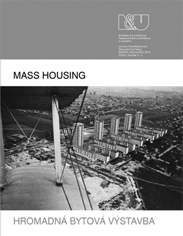CZECH PANELÁKS ARE DISAPPEARING , BUT THE HOUSING ESTATES REMAIN
CZECH PANELÁKS ARE DISAPPEARING , BUT THE HOUSING ESTATES REMAIN
Author(s): Kimberly Elman Zarecor, Eva ŠpačkováSubject(s): Cultural Essay, Political Essay, Societal Essay
Published by: Historický ústav SAV, v. v. i.
Keywords: housing estate; panelák; prefabrication; socialist realism; apartment building; state; privat; preservation
Summary/Abstract: A common lament about the legacy of communism in Europe is the damage that it did to the built environment. Particular ire is directed at the concrete prefabricated housing blocks, known in Czech and Slovak as paneláks (structural panel buildings), groups of which were arranged in housing estates (sídliště in Czech and sídlisko in Slovak) to create the region’s characteristic postwar districts. Paneláks were not only signs of the increased production of new housing, but also indicated the acceleration of urbanization in the region as residents moved from rural areas to towns and cities for work. According to United Nations statistics, 75 percent of the Czech population lived in urban areas by 1980, compared to only 54 percent in 1950. These new residents were the first inhabitants of the panelák housing estates, and many of them and their families remain there today. Scholars and the general public have long assumed that the Soviets were behind the spread of these buildings, but the technology and its logic had local origins as well. Some of the hallmarks of socialist-era architecture, such as prefabrication and mass production, predate state socialism by decades, especially in Czechoslovakia, where the interwar building industry was one of the most advanced in Europe. The specific panelák technology used in Czechoslovakia had direct ties to capitalistera experimentation in the Building Department at the Baťa Shoe Company in Zlín. Although Stavoprojekt, a state-run system of architecture and engineering offices, replaced private practice in the late 1940s and changed the profession profoundly, the vast housing estates in many Czech and Slovak cities are, in fact, the fulfillment of an interwar vision of modernity that emphasized the right to housing at a minimum standard over the artistic qualities of individual buildings; in other words, function and efficiency over style. Thus, after World War II,far from being pressured by Moscow to build standardized apartment blocks, many architects in Czechoslovakia, still inspired by the program of the interwar avant-garde, embraced the opportunity to build housing on a scale and at a pace previously unattainable. By the mid-1960s, paneláks were the norm and they remained the dominant new housing type until 1990. Today there are 1,165,000 apartment units in 80,000 paneláks in the Czech Republic. More than 30 percent of the country’s inhabitants live in a panelák (approximately 3.1 million people) and 40 percent of Prague’s inhabitants. The inventory is highly standardized and located in all cities and towns – large and small, urban, suburban, and rural. As interest in the preservation and protection of modern architecture increases through the efforts of DOCOMOMO and other groups, statistics such as these indicate the complexity of talking about patrimonialization (listing or gaining heritage protection) for mass housing projects in the Czech Republic. These ubiquitous buildings are no longe...
Journal: Architektúra & Urbanizmus
- Issue Year: 46/2012
- Issue No: 3-4
- Page Range: 288 - 301
- Page Count: 14
- Language: English

